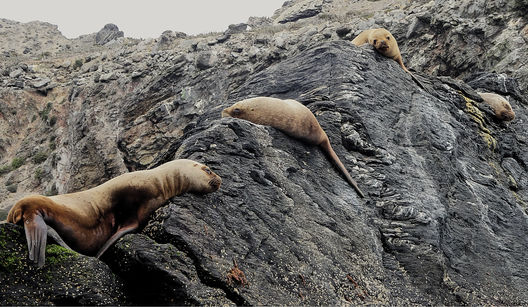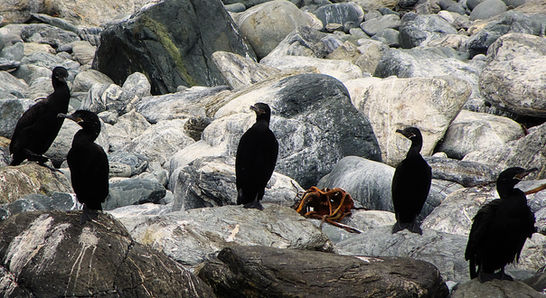
La Serena and the Elqui Valley
Chile
La Serena is the second oldest city in Chile, and it looked it. The centre was filled with crumbling beige and maroon buildings, which held a certain charm but wouldn't be called attractive. There was a distinct lack of tourism except for the centrally located La Recova market, full of souvenir stores but no customers. It was a nice change being able to walk around without being hassled by touts, although there were plenty of beggars on the streets pleading for one thing or another in Spanish.
Roughly 13 km away was the Cruz de Tercera Mileno (Cross of the Third Millennium), a large cross on a hill overlooking the coast. Rather than taking public transport, we decided to walk the whole way along the beach, listening to the gentle waves lapping on the shore. A few people were brave enough to enter the freezing water, but we had no desire to join them. The coastal road was lined with palm trees, hotels, beachside cafes and apartment buildings that were slightly more modern than what we found in the city centre.
Ascending to the top of the cross required purchasing a ticket, but we felt the view from the bottom was enough. On both sides of the hill the shore stretched out into an indistinct haze, while the foreground was filled with pops of colour from nearby roofs. If we had chosen to climb up to the top we could have seen the water wrapping around the front of the hill as well, although I don’t think we really missed out on much.
Back in town we wandered through the Japanese Gardens, a compact but beautiful space filled with Japanese-inspired features. The only downside were the main roads running along 2 of the borders, resulting in constant traffic noise disturbing the peace that it deserved.

The main reason I wanted to visit La Serena was to see the Humboldt penguins who live just offshore on Choros Island. Rather than join an expensive tour, we caught a bus 2 hours north to the ferry terminal in Punta Choros. After reading other people's experiences, I was expecting the port to be full of touts, tour companies, tourists and frequent boat departures. Instead, only a handful of us got off the bus, walked over to the one and only office without being approached by anyone, bought a ticket for the one and only boat trip today, and waited around for an hour for a few other people to arrive. I guess it wasn't that popular anymore.
On the trip out to the island we sat in an open-air boat, which froze me to the core. The continual drenching of sea spray didn't help. We couldn't even look around because as soon as we put our heads up, we were smacked in the face with more water. A long half hour later we arrived at Choros Island, where our driver slowly navigated the vessel along the rocky shore. Our guide only spoke Spanish, so it was more of a visual tour for us. The island seemed to be composed entirely of jagged rocks and bird poo, with a large number of various bird species perched around the place. Every now and then a cavern appeared, and our boat nervously tried to enter one for a close-up view. Although the dramatic coastline was interesting, it wasn't what we were here to see.
It wasn't long before we spotted our first sea lions, who were happy to pose for the camera. Soon after we located the Humboldt penguins, who annoyingly blended in very well with the poop-covered rocks and were hard to see from afar. Other than a small group sitting on top of a rock, they were mostly found alone, sleeping and not doing much else. There weren't nearly as many penguins as I had hoped, and by the end of the tour I think we had seen more sea lions than penguins.
Afterwards we made the short trip to Damas Island, where we docked, listened to a long spiel about all the regulations on the island, then explored the area on our own. We followed an interpretive trail up to a small mirador, passing craggy rocks interspersed with tall cacti. Overall there wasn’t much to see, and we spent most of our time trying to stay out of the bitter wind. The only animals we saw were thousands of Kelp gulls and the odd vulture. Finally we all boarded the boat again and set sail for the mainland, which was thankfully much drier than the outgoing journey.

The Elqui Valley, a couple of hours inland from La Serena, is the home of pisco in Chile (pisco being a distilled grape spirit that’s considered the national drink of Chile and Peru). Numerous distilleries and wineries are dotted around the mountains, as well as a token craft brewery. Again we declined a tour and instead opted to cycle around the region, allowing us to stop every few kilometres for another tasting. We found a company who rented out bikes and could drop us off at the top of the valley in the town of Alcohuaz. From here, the road wound downhill through the touristy village of Pisco Elqui and onto our final destination today, Vicuña. We weren't sure how we would feel after cycling 50+ km while consuming copious amounts of alcohol, but we were willing to find out.
On the drive to the start point we passed vineyard after vineyard, all sprouting healthy, bushy vines. The further we ventured the more the valley opened up, with bare brown mountains running down each side and bright green foliage carpeting the floor. Most of our bike ride today would afford us the same spectacular views.
Not even 5 minutes into our journey, Danny spotted a winery and had to stop. Vinedo Alcohuaz only produced red wines and they gladly let us sample 4 of them for free. Each of the wines was excellent, and it ended up being our favourite tasting of the day.
Next up were the piscos. Somehow, we completely missed the first distillery and were surprised when we arrived at the second on our list, Doña Josefa. Tours were free but only in Spanish, but luckily we were able to talk our way into a private pisco tasting in English without the rigmarole of a tour. Five tastings later, with the final one having an alcohol concentration of 46%, and we were starting to feel the buzz.
The largest and most commercial distillery in the region is Mistral, but this was our least favourite stop. When we arrived the man at the door had no interest in helping us, so we wandered around until we found someone who did. As we weren't prepared to wait over an hour for the next tour, we instead bought a tiny flight of piscos for an exorbitant price and sat on their beautiful but empty deck. The piscos weren't that good. No wonder no one else was here.
Further on down the road we found another winery, Caves del Valle. Here we were able to try 5 wines that were all made with muscat grapes, which weren't really to our liking. Afterwards, the guide showed us around their compact processing facilities and let us wander among the vines, which made up for the underwhelming tasting.

Based on a recommendation, we pulled over at a roadside stall for a copao juice. Copao is a type of cactus native to Chile with a sweet, citrusy fruit, and its juice was the perfect refreshment for the blazing hot conditions we were riding through. After sobering up slightly, we turned off the highway and rode down into the valley, where vineyards lined both sides of the quiet road. Sadly the tranquil conditions didn't last long, and when we returned to the highway we found ourselves in a wind tunnel that saw us pedalling strenuously for little reward. This was the least enjoyable section of the day.
Eventually we made it to Guayacan Brewery, located in the colourful town of Diaguitas. The roads were full of street art but seemingly very few residents. Most of the other customers in the brewery were tourists also cycling through the valley. We sat in their peaceful beer garden, where Danny happily devoured a flight of 6 of their beers. They weren't exactly small pours and he was definitely feeling the effects by the end. I wasn't too upset to sit this one out.
The final stop was AbA Distillery, a small venue that felt like a backyard operation. Here we sampled 4 pisco fruit liqueurs for free, which were all sweet and not too strong in alcohol (probably a good thing by this stage). By the time we dropped off our bikes in Vicuña, we had cycled approximately 57 km, although I don't think we had to pedal for at least 30 of those kilometres.
Vicuña was a picturesque town, as colourful as Diaguitas but much bigger and livelier. Danny decided he had earned an unhealthy meal after all the sitting he did on the bike, so for dinner he ordered a Chilean speciality, chorrillana, which is kind of like loaded fries. There are many different versions, but each one is a heart attack on a plate. This one consisted of a huge layer of fries topped with melted cheese, strips of meat, sausages, onions, mushrooms and served with a side of mayonnaise. He couldn't finish it.
The following morning, after a quick hike to a viewpoint over Vicuña, we walked out to the final distillery in the area, Capel. We weren't expecting much but what we found blew us away. The facility was gigantic, and the tasting room and the outdoor eating area were much more upscale than we anticipated. Dozens of different types of pisco, wine and cocktails were for available for purchase- it was clear they produced a lot of alcohol. Using my broken Spanish we managed to talk ourselves into a free private tour in English (usually there was a fee), taking us through the museum and underground cellar. It was one of the more in depth tours we had joined, and even wine guru Danny learnt quite a bit. Most visitors weren't allowed to enter the barrel room, but our guide kindly let us wander through the vast space, with over 3,800 barrels stacked up in rows. The smell of fermenting grape juice was overwhelming. At the end we were given 4 tastings and we came away with 2 bottles - not bad for a place we only visited as a way to fill in time.















































